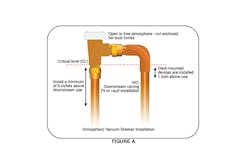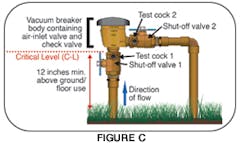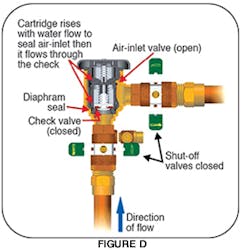When I was in college — more years ago than I would like to admit — I served as a resident assistant in my university's residence halls. Each floor had a vacuum students could use to clean their rooms. Despite the infrequency with which college students actually used the vacuums, it was amazing at how often they were broken. It turns out that the rubber band that spins the brush in the vacuum head is really no match to the vast cornucopia of odd items that young adults attempt to suck off their floors. Strands of long hair, socks, power cords, money, toilet paper, tin foil, as well as other "not safe for publication" items were all found to have disabled the economically priced vacuum cleaners provided for student use. At this time in my life, vacuum breakers would have held a completely different meaning to me than it does today after years of exposure to the plumbing industry.
In the plumbing world, the need to protect the potable water supply from the dangers that come from backflow and back siphonage is so well understood that to call it common knowledge would be a bit of an understatement. The 2015 Uniform Plumbing Code touches on the various methods to prevent backflow and backsiphonage in section 603.3, but diving a bit deeper could be useful.
The most basic form of protection is the presence of an air gap in between the possible source of contamination and access to the plumbing system, usually a plumbing fixture. However, other mechanical measures are often needed to guarantee this protection and understanding when exactly to use one method of protection or another is worth discussing. For this reason, we will discuss the other types of vacuum breakers — the ones that keep our drinking water safe.
Atmospheric vacuum breakers
The purpose of a vacuum breaker is to stop back siphonage. The atmospheric vacuum breaker consists of a check valve member and an air vent that is normally closed when the device is pressurized. The air vent allows air into the piping system for the purpose of stopping a siphon at the point of use (see Figure A). A common design element is that the air-inlet valve and check valve are nearly always the same mechanical component.
(See Fig. A, above)
Although simple in its design, the AVB has several installation requirements in order to function properly:
- Because the AVB provides back siphonage protection only, it is considered isolation protection only. These devices are located on individual plumbing fixtures and appliances. They will not be installed at the service line to a building, for example, where the device may be subject to backpressure.
- All vacuum breakers are considered high-hazard protection. These devices protect the potable system from toxic materials. Remember that any backflow preventer that provides high-hazard protection will be acceptable for low-hazard applications.
- The AVB must be installed with its critical level a minimum of six inches above the highest downstream piping and flood level rim of receptor (see Figure A). A deck-mounted AVB must be installed with its critical level no less than one inch above the flood level rim of the fixture.
- The AVB must not be subjected to more than 12 hours of continuous water pressure. If the AVB is used with continuous pressure, the valve may become stuck or sealed closed and not open on demand to atmosphere. The reasons for this may include mineral deposits or chemical bonding from water quality conditions, or a spider's web holding the valve closed to atmosphere.
- Valves are not permitted downstream of an AVB. Components such as check valves, gate valves, solenoid valves or pressure-regulating devices can trap or suspend pressure in the AVB, thereby allowing continuous pressure.
- An AVB must not be subjected to backpressure. This valve allows air into the system to stop a siphon with a water pressure loss. The device cannot determine the water's direction of flow, as long as water pressure holds the valve closed to atmosphere. Therefore, elevated piping, auxiliary sources of water and pressure pumps, for example, are not permitted downstream.
- AVBs must be installed upright. The valve that allows air into the downstream piping relies on gravity to function properly. If the device is installed out of plumb, the valve may not fully open.
Hose connection vacuum breakers
A hose connection vacuum breaker should be installed on each faucet or hose bibb that is connected to the potable water supply to prevent backflow into the water supply. HVBs must be installed at least six inches above the ground surface. The HVB is an AVB and must follow the installation parameters of Table 603.2. Most HVBs have a set screw that prevents them from being easily removed once they are installed. This prevents them from being removed when the garden hose is removed. Once the HVB is installed, no further adjustments are required (see Figure B).
The spring-loaded check valve does not allow drainage of water from between the hose bibb and the upper part of the HVB; thus, freeze protection must be provided, just as all outdoor plumbing would need to be protected under freezing conditions.
HVBs should be inspected and tested periodically to ensure they are working properly. Fortunately, their mode of operation permits inspections to be easily made. Verify the check valve closes and the atmospheric vent opens reliably whenever the water supply is shut off. It is very simple to do this if a nozzle that can be shut off is used on the end of the hose. When the nozzle shuts off, turn on the faucet and allow the hose to pressurize. Then, shut off the faucet while the hose is pressurized. After a few seconds, the hose pressure should be released in a small spray as the atmospheric vent suddenly opens.
Pressure vacuum breakers
The pressure type vacuum breaker evolved from the AVB. There are a number of AVB installation restrictions due to the limits of the design. One of the AVB's limitations is the restriction of no continuous water pressure. The concern of the inlet valve sticking closed is a serious one, as it would render the AVB useless. The PVB was designed to overcome this problem.
The AVB has one moving part that works as an air inlet or port and it serves as a check valve to the supply piping when no water pressure is present. The PVB check valve is similar but spring loaded. When the piping-system pressure is reduced, the spring forces the check open to the atmosphere, allowing air into the system and breaking the downstream siphon.
The continuous pressure restriction would no longer apply and would allow valves downstream and water pressure 24 hours per day. This type of assembly may be used only where outlet pressure will never exceed inlet pressure and is not subject to backpressure. This device may be installed indoors only if provisions for spillage from the dome are provided. They must be installed a minimum of 12 inches above the highest piping downstream of the PVB (see Figure C).
Spill-resistant vacuum breakers
The spill-resistant type vacuum breaker is essentially a next-generation PVB. This assembly evolved because of the spillage encountered with the PVB. The function of the SVB is to eliminate the water spillage of the PVB.
When it comes to the potable water supply that the public utilizes, safety is the first priority. Vacuum breakers play an important part in that effort, and understanding when and where to use them and how they work can help maintain the highest level of safety.



